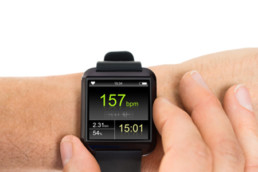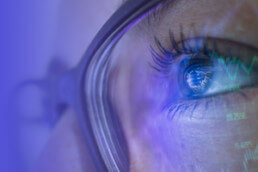Design Challenge: Displays for Wearables
The market for wearable electronic devices is growing rapidly, with applications from fitness bands that count your steps to complex devices for health and medical applications, such as an artificial pancreas or kidney. Many factors have made this explosive growth possible, including the production of low-cost, tiny sensors that can measure motion, pressure, and temperature, or even capture images or video.
These devices often communicate wirelessly to a smartphone or other mobile device, both to send data for storage, analysis, and reporting, but also to receive instructions. Many devices have other ways to communicate to the wearer through a user interface that can include inputs from buttons, touch panels, and even motion sensing. For the device to deliver information, however, a display remains one of the most efficient ways to communicate with the user.
Wearable displays run the gamut from absurdly simple to sublimely complex. At the simple end of the spectrum, you can have a single indicator light. In this case, a LED is often used to convey a single bit of binary information such as whether the device is powered on or off. That single point of light can be used to deliver more information. By varying the color and intensity of the light – and controlling whether it is on steadily or flashing at different rates, – interface designers can convey many different messages to the user about the state of the device.
The next step in a wearable display is the use of segmented elements to show letters and digits. These have the advantage of still requiring relatively small amounts of data to drive a display that conveys a lot of information. From here, the next step is an “active matrix” display that gets its name from being able to turn individual pixels on and off to create any image you want.
One problem with most wearable device displays is that the space available for a panel is extremely limited. As a result, the pixels generally need to be very small if they are going to be able to show more than just a few digits. If the device is going to show the contents of a text message or a map showing the user’s location, then a high-resolution panel will be required.
Fortunately, design engineers have a number of different display technologies from which to choose. At one end, there are bistable displays that require very little power but tend to have lower resolutions. At the other end of the continuum, there are LCD and OLED panels that have very high resolution and can show beautiful images in full color.
Design engineers are faced with many choices in picking a suitable display for a wearable device. It must be able to convey enough information to the user. It needs to have power requirements that can be met by the available battery storage and still deliver sufficient useful time between charging sessions. If the device is intended to be used in low-level lighting or dark settings, then the display must emit enough light to be seen; this can be a challenge for some of the bi-stable technologies such as electronic ink displays.
On the other hand, if the device is to be used outdoors and possibly in direct sunlight, then the display panel must have sufficient contrast in order to be easily viewed under very bright ambient light conditions. Some LCD panels have a combination of a reflective backplane along with a backlight so that it can be viewable under a wide range of lighting conditions.
The display panel must also be considered as part of the total device. Adding components such as a touch panel or protective cover glass can have a significant negative impact on the display’s performance under certain circumstances. In order to effectively evaluate the options, the panel’s operation must be measured under the various conditions.
One of the most important measures of a display’s performance is to accurately measure the contrast and not just straight on but from angles that the user might use under normal situations. The contrast will vary significantly under different lighting conditions, so measurements must be taken at a range of ambient light levels.
Ambient lighting conditions will also impact color performance, so if color reproduction is an important part of a wearable device’s mission, color measurements need to be taken across the same range of lighting levels as well. Konica Minolta Sensing Americas has a number of display measurement systems available as well as incident light meters to measure ambient light to meet the ever-changing needs of the display industry.
About the Author: Alfred Poor, Ph.D., is a display technology expert and has been honored as a Senior Member of the Society for Information Display. You can contact him at apoor@verizon.net.










